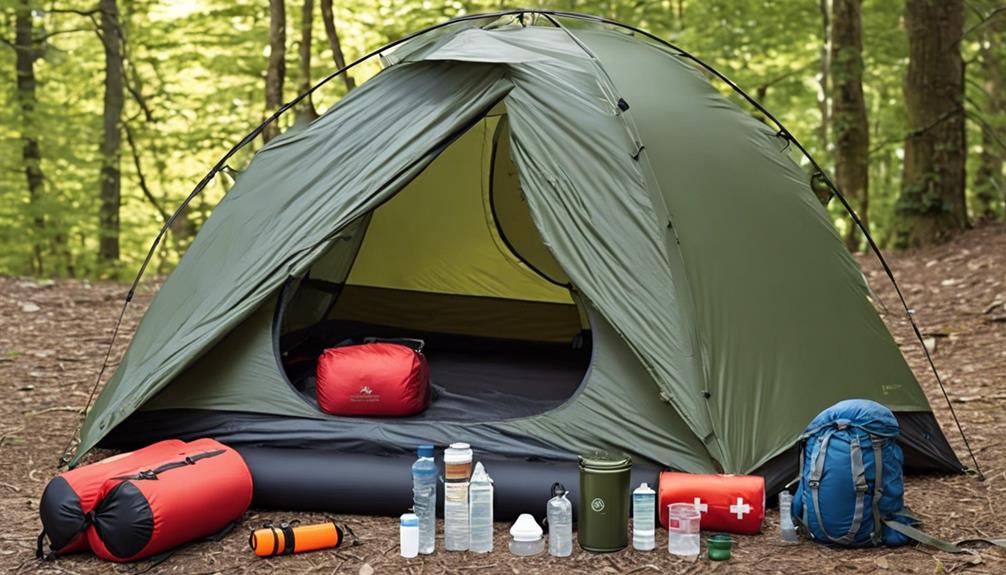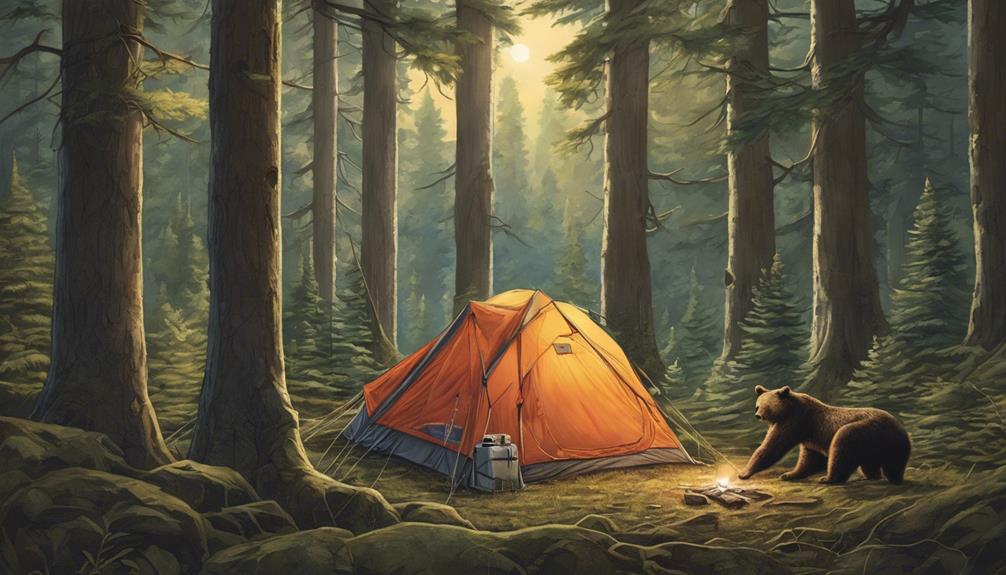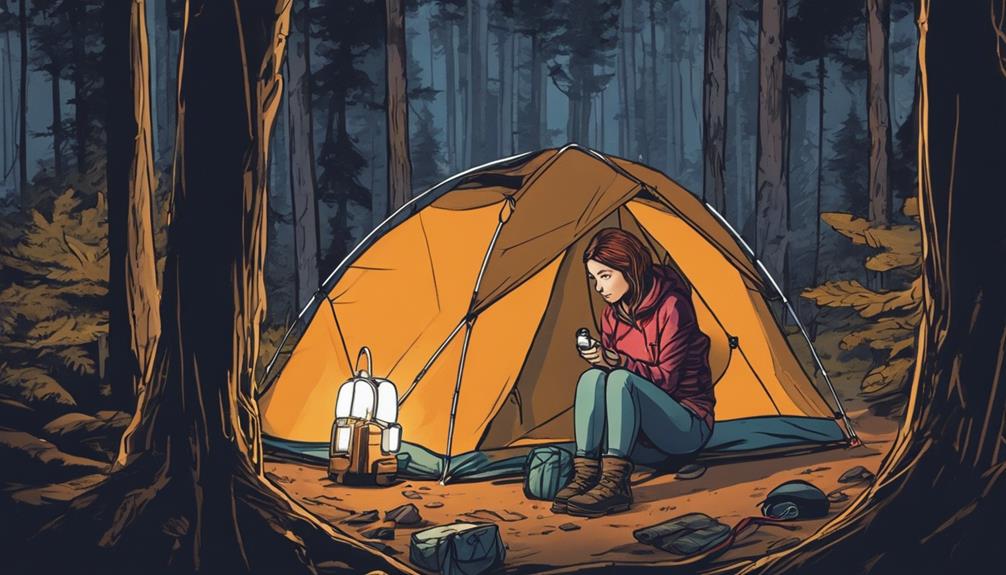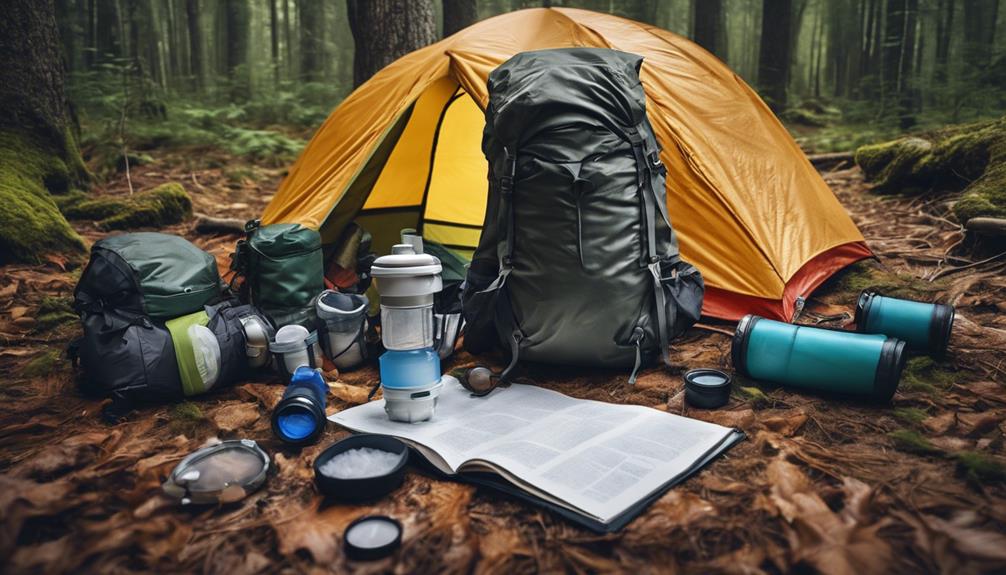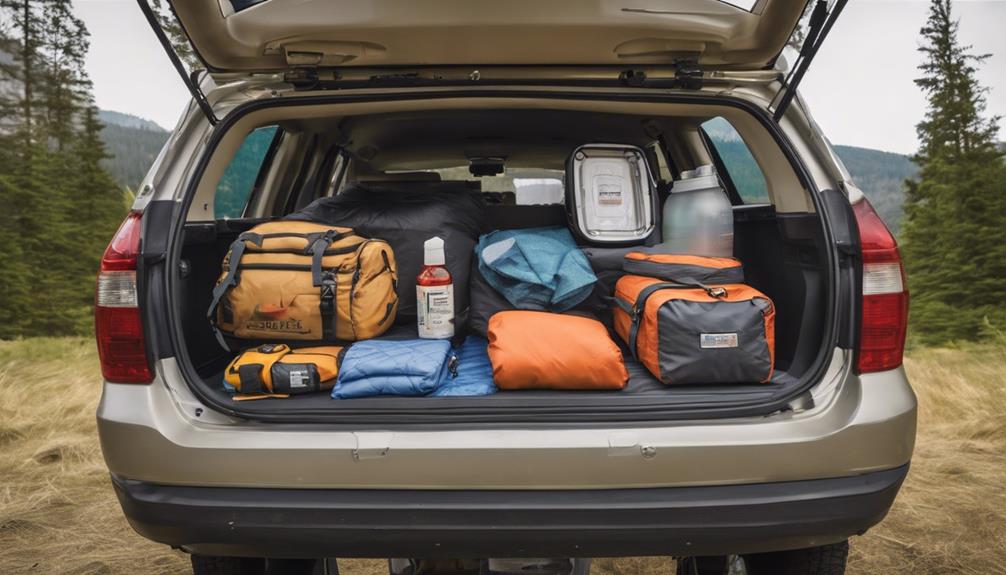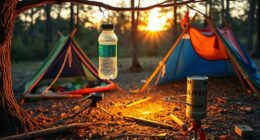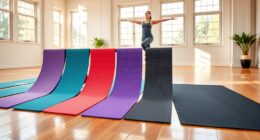Begin your solo camping journey well-equipped with our comprehensive guide. Remember to pack a lightweight and sturdy shelter such as the Big Agnes Fly Creek HV UL Solo tent, accompanied by a cozy sleeping bag like The North Face Cat’s Meow 20F. Essential items to bring include a high-quality sleeping pad, camp pillow, and a dependable compass for navigation.
Your safety matters, so be prepared with essential gear and skills for any circumstance. Remember, being prepared is key to a successful outdoor experience.
Key Takeaways
- Choose a lightweight tent and sleeping gear for solo comfort and convenience.
- Pack essential cooking equipment and non-perishable food for sustenance.
- Carry navigation tools and safety items for emergencies and direction.
- Wear appropriate clothing and footwear for comfort and protection.
- Include miscellaneous items like earplugs and a warm blanket for added comfort during solo camping.
Essential Shelter and Sleeping Gear
When embarking on a solo camping adventure, our essential shelter and sleeping gear serve as the cornerstone of a restful and secure night under the stars. For solo camping, selecting the right tent is crucial. Opt for a lightweight and compact option like the Big Agnes Fly Creek HV UL Solo, ensuring easy packing and transport without compromising on durability.
A warm and compressible sleeping bag, such as The North Face Cats Meow 20F, is vital for a comfortable night's sleep in various conditions. Pairing it with a quality sleeping pad like the Big Agnes Insulated AXL Air Sleeping Pad not only enhances insulation but also guarantees optimal rest.
Don't overlook the importance of a camp pillow like the Sea to Summit Aeros Premium Pillow to elevate your comfort levels during solo camping trips. Prioritizing durable, high-quality shelter and sleeping gear designed specifically for solo camping conditions is key to ensuring a successful outdoor experience.
Crucial Cooking Equipment and Supplies
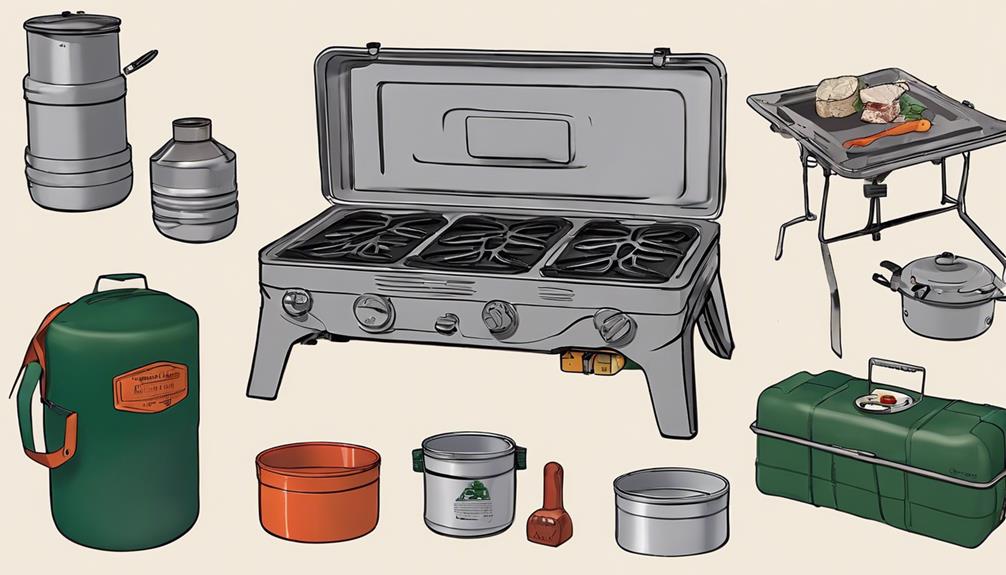
Let's delve into the essential cooking equipment and supplies that are crucial for your solo camping adventures. When it comes to cooking in the wilderness, having the right gear can make all the difference. A portable stove is a must-have item for preparing hot meals while on your solo journey. Pair it with lightweight cookware and utensils to make meal preparation a breeze.
To ensure you have sustenance during your outdoor escapades, pack non-perishable food such as dehydrated meals, energy bars, and nuts. For those who can't start their day without a caffeine fix, consider bringing along a compact coffee maker or kettle for a comforting brew in the tranquility of nature. Hygiene is essential even when camping solo, so don't forget to bring biodegradable soap for cleaning your cookware and maintaining cleanliness.
Lastly, save space and weight in your backpack by opting for multipurpose tools like a spork or camping utensil set. These versatile items can serve multiple functions, making them invaluable additions to your camping essentials.
Vital Navigation Tools and Safety Items
To navigate safely on solo camping adventures, equipping oneself with vital navigation tools and essential safety items is paramount. When venturing into the wilderness alone, being prepared can make all the difference. Here are three crucial items to ensure your safety and peace of mind:
- Compass: A reliable compass is a timeless navigation tool that can guide you when other devices fail. Knowing how to read a compass and orient yourself in relation to your surroundings is a fundamental skill for any solo camper.
- Map: A detailed map of the area you plan to explore is invaluable. It provides a broader perspective of the terrain, water sources, and potential hazards. Combining a map with your compass skills can help you plot your course accurately.
- Emergency Communication Device: Whether it's a satellite phone, a personal locator beacon, or another form of emergency communication, having a reliable way to call for help in case of unforeseen circumstances, such as a bear encounter or injury, is essential for your safety during solo camping expeditions.
Important Clothing and Footwear Choices

We prioritize selecting clothing and footwear that offer comfort, durability, and functionality to enhance our solo camping experience in the great outdoors.
When it comes to footwear, versatile hiking boots like the Danner Inquire Chukka Mid Hiking Boots provide the support and durability needed for long treks. Pair these boots with moisture-wicking socks such as the Smartwool PhD Outdoor Light Mini Socks to keep your feet dry and blister-free.
For clothing choices, opt for breathable hiking tops like the Vuori Lux Performance Tank Top for effective moisture management during strenuous activities. Don't forget a high-quality sports bra like the Pure Bra for essential comfort and support while on the move. Additionally, pack durable hiking pants like the Fjallraven Nikka Trousers for protection and flexibility on the trail.
Key Miscellaneous Items for Comfort and Convenience
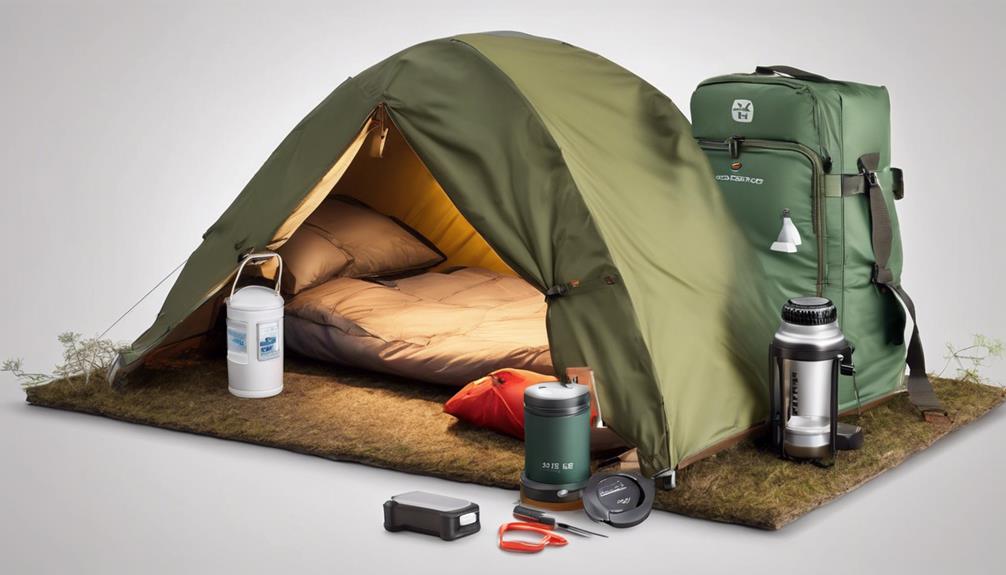
When planning for solo camping trips, the inclusion of key miscellaneous items for comfort and convenience is essential to enhance the overall outdoor experience. These items can make a significant difference in your comfort levels and overall enjoyment during your solo adventures.
Here are three must-have items that can elevate your solo camping experience:
- Inflatable Pillow: Packing an inflatable pillow can greatly improve your sleeping comfort in the wilderness. It provides crucial support for your head and neck, ensuring a restful night's sleep after a day of outdoor activities.
- Earplugs: Including earplugs in your gear can help you block out unwanted noise from nature or neighboring campsites. This simple addition ensures a peaceful and uninterrupted night's rest, allowing you to wake up refreshed and ready for the day ahead.
- Warm Blanket: Carrying a warm blanket is essential for staying cozy on cool evenings. Whether you use it inside your tent or while stargazing outside, a warm blanket offers comfort and warmth during chilly nights under the stars.
These miscellaneous items, combined with your tent and camp chair, will provide you with the comfort and convenience you need for a successful solo camping trip.
Frequently Asked Questions
How Do I Plan My First Solo Camping Trip?
So, planning your first solo camping trip, huh?
Well, first things first, we gotta choose a sweet spot, map out the route, check that weather app like it's our job, and pack like there's no tomorrow.
Don't forget to fill in your peeps on your plans, just in case.
It's all about being prepared and stoked for the adventure that lies ahead.
Now let's get this show on the road!
What to Do While Solo Camping?
While solo camping, we immerse ourselves in nature, embracing solitude and tranquility. Engage in activities like hiking, fishing, or stargazing to connect with the environment. Practice mindfulness and bring a journal to document thoughts and experiences.
Explore the area through walks, runs, or photography. Disconnect from technology to fully appreciate the wilderness. Make the most of your solo camping experience by enjoying the peacefulness and beauty of nature.
How Do You Plan a Camping Trip for Beginners?
When planning a camping trip for beginners, we focus on choosing a beginner-friendly location with accessible amenities and moderate terrain.
We create a detailed packing list tailored to their needs, emphasizing safety and comfort.
It's crucial to familiarize ourselves with basic camping skills, like tent setup and food storage, to ensure a smooth experience.
Joining a guided tour or seeking advice from seasoned campers adds valuable insights and boosts confidence for a successful trip.
Can You Go Camping by Yourself?
Absolutely, we can go camping by ourselves! It's an empowering and enriching experience that allows us to embrace solitude, self-reliance, and nature's beauty.
Being well-prepared with the right gear, skills, and knowledge is key to a safe and enjoyable solo camping adventure. Remember to always inform someone of our plans for added safety.
Solo camping offers a unique opportunity for personal growth, confidence building, and deep connection with the natural world.
What Essential Items Do I Need for Solo Camping Activities?
When preparing for solo camping activities in nature, essential items like a reliable tent, sleeping bag, camping stove, water purification system, first aid kit, and versatile clothing are crucial. It’s also important to bring a map, compass, flashlight, and multi-tool for safety and convenience.
Conclusion
In conclusion, solo camping is a rewarding experience that requires careful planning and the right gear.
Did you know that 64% of solo campers feel more connected to nature and themselves after a trip?
With the right essentials and a sense of adventure, you can enjoy the great outdoors and create unforgettable memories.
So pack up your gear, hit the trails, and embrace the solitude and beauty of nature!

